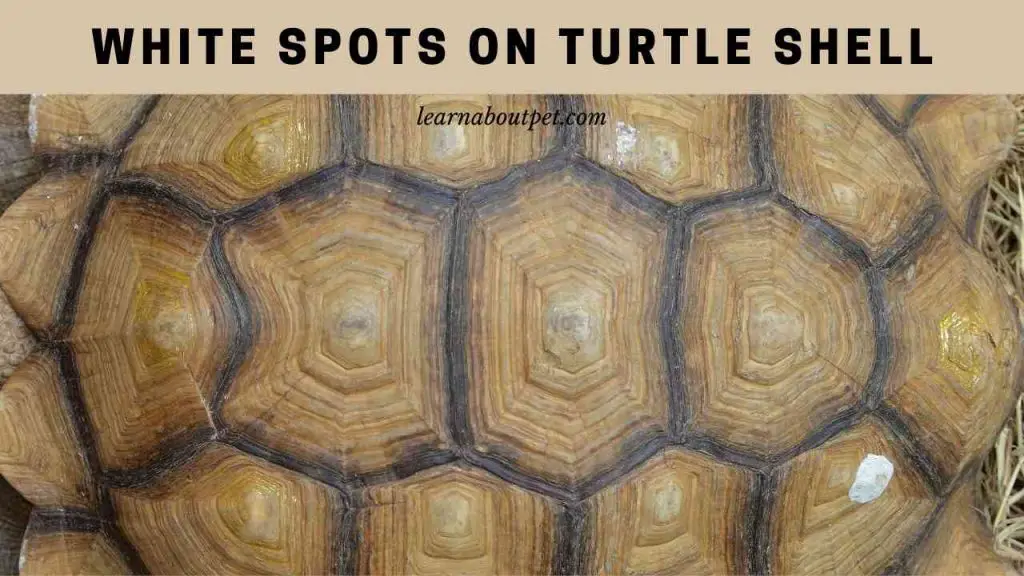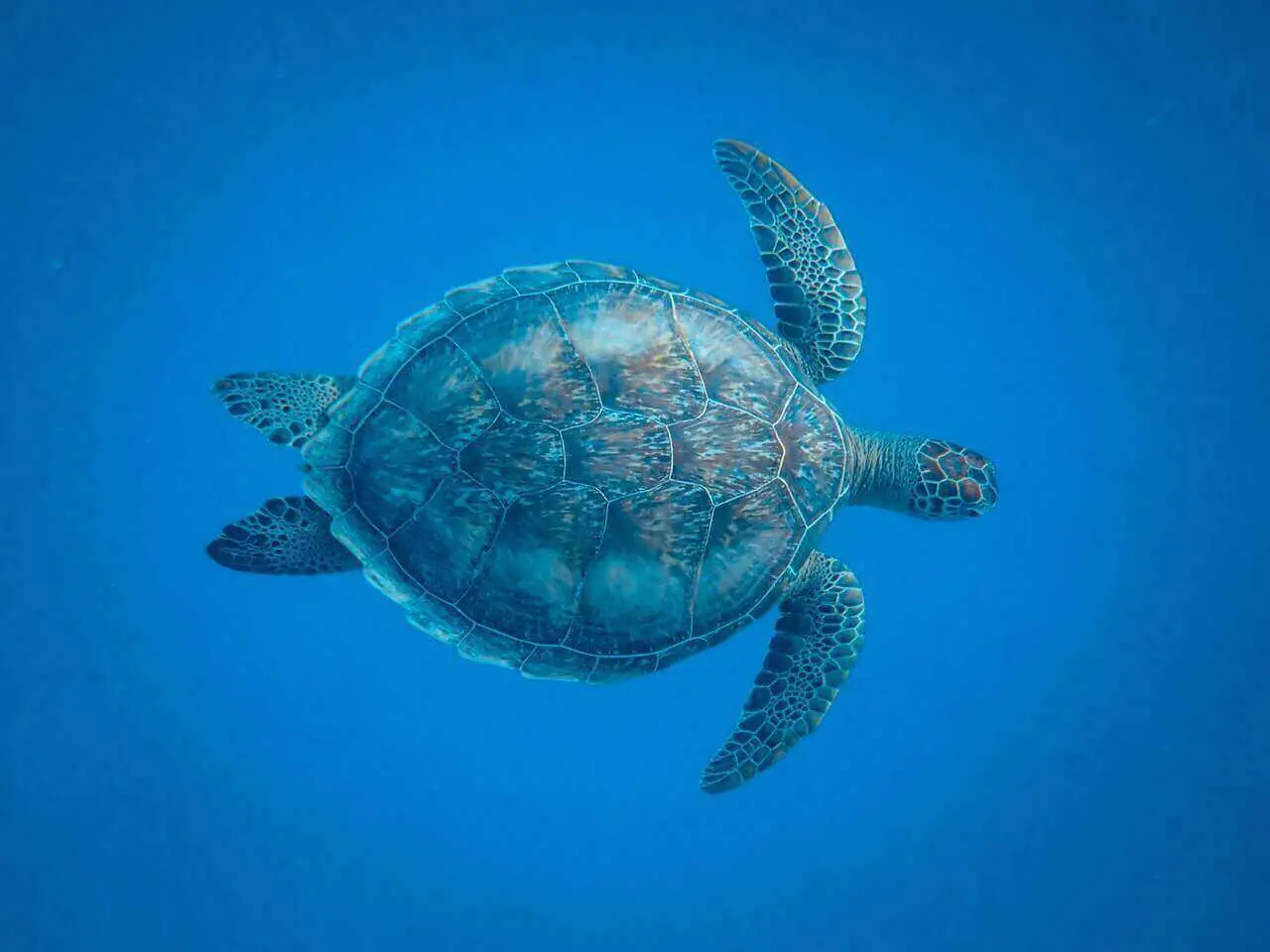It can be quite alarming to discover that your turtle has white spots on its shell. Upon making this discovery, you will probably want to know what may be causing these spots, and what you can do about them. Read on, for answers.
White spots on turtle shell may be due to hard water. They could also be due to fungal infection. More ominously, they could be due to shell rot. How to get rid of the spots depends on the cause. It may entail switching from hard turtle tank water to soft water. It may also entail the use of salt baths or medications.
We may also mention that there are cases where skin and scute shedding causes turtles to have white patches on their shell. They have potential to be mistaken for white spots.

But then again, those will normally only be visible when the turtle is submerged in water: not when it is dry.
What Color Are Turtle Shells Normally?
Before proceeding with this discussion on white spots on turtle shell, it is a good idea for us to first have insight on the common turtle shell colors.
As it turns out, turtle shells are normally black, brown or gray. Dark green is also a common turtle shell color. Sometimes, a turtle may have a combination of these colors on its shell.
For instance, the yellow belly turtle typically has a brown and black shell (sometimes with stripes whose color is yellow)…
So what you may be looking at is a scenario where you have a turtle with white spots on shell whose base color is brown.
Or it may be a case where a turtle has white spots on shell whose base color is gray.
It could even be a scenario where a turtle with a brown and black shell has white spots on it.
That would, for instance, be the case in a yellow belly turtle (whose shell, as we have already seen, is usually blown and black).
So here, you have white spots on yellow belly turtle shell (whose color is normally brown and black).
When you get to think of it, there are many possibilities.
But turtle shells are normally black, brown, gray, dark green or in combinations of these colors – like brown and black or brown and gray.
And appearance of white spots on turtle shells is a phenomenon that is quite common.
What Causes White Spots On Turtle Shells?
There are four things that can potentially cause white spots on turtle shells.
First is hard water. If the water in the tank where you keep your turtle is of the hard variety, the turtle may eventually develop white spots.
Second is fungal infection. If there is a fungal infection on the turtle’s shell, the end result may be white spots.
Third is a condition we refer to as a ‘shell rot’. It is a serious condition, and it often causes turtles to end up with white spots on their shells.
Fourth is the routine shedding of skin and skutes in turtles. This can cause a turtle to have white patches (which some people refer to as white spots) on its shell.
Therefore in a situation where my turtle has white spots on his shell, these are the possibilities I would think of.
In other words, upon finding white spots on my turtles shell, I would tend to zero in on one of these possibilities.
Let us now look at each of these potential causes of white spots on turtle shells in turn.
Hard Water As A Cause Of White Spots On Turtle Shell
One of the commonest reasons for turtles ending up with white spots on their shells is exposure to hard water.
Hard water is that which has dissolved minerals – typically calcium and magnesium.
Now most of the water that is available in municipal lines all over the US is of the ‘hard’ variety.
The white spots that are as a result of hard water will tend to be large. They may actually qualify to be termed as patches, rather than spots in the strictest sense of the word.
Further, the white spots that are as a result of hard water will tend to have a chalky appearance.
And if you apply vinegar on them, it fizzes.
This particular type of white spots can appear on any type of turtle. For instance, you can have a case of a red eared slider turtle white spots on shell as a result of hard water exposure.
Or you can just as easily have a case of white spots on painted turtle or snapper turtle shell, arising from hard water exposure.
However, there are cases where hard water exposure may be an unlikely cause for white spots.
Suppose, for instance, yours is a case in which you are seeing white spots on box turtle shell? Now this would be interesting, because the box turtle is a land turtle, which hardly ever finds itself submerged in water.
So that would effectively be the same as a case of white spots on tortoise shell.
In such scenarios – where you are dealing with turtles that never get into water – the possibility of the white spots being due to hard water would be remote.
But for turtles that often find themselves submerged in water, the white spots may be due to hard water exposure.
Fungal Infection As A Cause Of White Spots On Turtle Shell
There are instances where turtles end up with white spots on their shells due to fungal infections.
The white spots in this case tend to be rather small. So they are real ‘spots’, rather than ‘patches’. But they may be many, covering big swathes of the shell surface – though the individual spots are small.
Generally, upon encountering really small white spots on turtle shell, this is the key possibility to consider.
Sometimes though, what you may find are actually green spots, with white patches around them. In fact, when you research on what does fungus on a turtle shell look like, this is the answer you commonly get.
When you apply vinegar to these spots, no fizzing takes place. This differentiates them from those that arise due to hard water exposure.
Their small size is another thing that sets them up apart from those that arise due to hard water.
If the tank where you keep your turtle doesn’t have a proper basking spot, you may end up with this problem of fungal infection.
Further, if you don’t regularly clean the tank/change the water, you may create the right conditions for growth of fungi.
And the fungi may eventually infest the turtle’s shell. Then one of the symptoms would be these white spots.
The fungal infection, leading to white spots on the shell, can affect pretty much any type of turtle.
For instance, you may have fungal infection white spots on turtle shell red eared slider. Or you may have fungal infection causing white spots on the shell of a painted turtle, snapper turtle or any other.
Even land turtles, like the box turtles can end up with these particular white spots.
They tend to proliferate, if no treatment is given.

Shell Rot As A Cause Of White Spots On Turtle Shell
Shell rot is arguably the most worrisome of all things that may cause a turtle to have white spots on its shell.
In most cases, the pathogen responsible for causing shell rot is either bacteria or fungi.
The problem with shell rot is in the fact that it can eventually enter the bloodstream, causing septicaemia, which is sometimes fatal to the turtles.
When there are injuries on the turtle’s shell, the pathogens that cause shell rot may enter through it.
Also, if the turtle is always in a dirty setup, the pathogens that cause shell rot can also get a chance to infect.
The white patches that arise as a result of shell rot will normally be modest in size. What sets them apart is the fact that pits tend to form around them. And they have a tendency to start turning red with time.
When you scrape these patches, there may be a bad smell.
Again, the white spots that are due to shell rot can be present in any type of turtle.
For instance, you may find white spots on turtle shell red eared slider that are due to shell rot. Or you may find white spots on a yellow bellied, painted, snapper or box turtle that are due to shell rot.
Of course, not all cases of white spots appearing on turtle shells are due to shell rot (as some people fear).
For instance, if you only have a case of a turtle shell white when dry, then it may not be due to shell rot.
Because shell rot can be fatal, white spots on turtle shell treatment should be urgent where the spots are clearly due to it.
Shedding As A Cause Of White Spots On Turtle Shell
Turtles do shed their skin and skutes.
And while the shell shedding process is ongoing, the shells may look as if they have white patches. These may be more common when the turtles are underwater.
The reason behind this phenomenon is air that gets trapped during the shedding process.
These too may be on any type of turtle that gets underwater. For instance, a case of white spots on red eared slider turtle shell may be on account of this.
Thankfully, once the shedding process is over, the spots/patches tend to disappear. They are usually not worth worrying about, if they are genuinely due to shedding.
Why Does My Turtle Have White Spots On Its Shell?
Upon noticing any white spots on your turtle’s shell, you would be entitled to ask this question: why does my turtle have white spots on his shell?
Or you may frame it in more general terms: why do turtles get white spots on their shells?
And as we saw earlier, the white spots can be due to hard water exposure. They can also be due to fungal infections or due to shell rot.
Skin and skute shedding can also cause turtles to have the appearance of white spots on their shells.
To know the exact reason behind the white spots on your turtle’s shell, you need to examine the spots’ sizes and patterns.
Where it is impossible to figure out the reason behind the white spots on your turtle’s shell, it may be ideal to consult a vet.
Why Is My Turtle’s Shell Turning White?
In most cases where you have your turtle’s shell turning white almost as a whole, the problem tends to be hard water exposure.
As we saw earlier, the white spots that are as a result of hard water exposure tend to be large. They are really patches, in most cases.
These can give the illusion of the shell’s turning white.
Here, you will normally also have some chalky substance on the shell. That can actually get you wondering, what is the white stuff on my turtle shell?
So that is one possibility.
Another thing that can cause your turtle’s shell to turn white is lack of a proper UV-B light. So this is yet another possibility to consider.
How To Treat White Spots On Turtle Shell
To put it differently, this is a question on how do you get rid of white spots on turtle shells?
And in practical terms, how to cure white spots on turtle shell depends on the underlying cause.
Where it is due to hard water, what you need to do is ensure that you switch to soft water. But change the water gradually, lest you induce the so-called ‘new tank syndrome’.
In the meantime, you can use apple cider vinegar to rub off the white substance from the turtle shell. Ensure the vinegar doesn’t get into the turtle’s eyes.
Where it is due to fungal infection, you can try a salt bath. Or you can use ointments such as iodine or betadine.
But also ensure that you identify what is making the turtle prone to fungal infections, and deal with it firmly.
In a case where it is due to shell rot, you may use silver sulfadiazine (or simply use iodine). If it is advanced (or spread out) though, it is best to take the turtle to a vet. Remember, shell rot can be fatal.
In a situation where the white spots appearance is due to ongoing shedding, you just have to bid your time. Do so till the shedding process is over. If the problem persists, consider other possible causes and maybe consult a vet.
Final Verdict – White Spots On Turtle Shell
White spots on turtle shell can be due to hard water exposure, fungal infection or shell rot. An ongoing skin and skute shedding process can also create the appearance of white spots on the turtle’s shell.
How to treat the white spots on the turtle’s shell will depend on the underlying cause.
Where they are due to hard water exposure for instance, you need to switch to soft water. Consider investing in a water softener.
If they are due to fungal infections or shell rot, consider using antimicrobial agents such as iodine or betadine. Salt baths may also be helpful.
But consult a vet if the problem persists in spite of such home treatment attempts.

To prevent the incidents of finding white spots on your turtle’s shell, consider only using soft water in the turtle’s tank.
Also maintain good tank hygiene and provide adequate UV-B lighting, with proper basking spots. That is to prevent fungal and bacterial infections that can cause white spots on turtles’ shells.
As a pet lover, make sure to learn about pet more and give your pet turtle a good and comfortable life!

Welcome to Learn About Pet. My name is Rajkumar Ravichandran and I love all pets, travel, and amazing food. I write about my passion and personal experience caring for multiple pets in this blog! ❤️
Post Disclaimer
DISCLAIMER: THIS BLOG OR WEBSITE, "Learn About Pet", DOES NOT PROVIDE YOU WITH MEDICAL ADVICE AND IS NOT A SUBSTITUTE FOR MEDICAL ADVICE. ALWAYS GET IN TOUCH WITH YOUR PERSONAL VETERINARIAN AND USE INFORMATION HERE AS GENERAL ADVICE.
The information, including but not limited to, text, graphics, images and other material contained on this website are for informational purposes only. No material on this site is intended to be a substitute for professional veterinary advice, food recommendation, diagnosis, or treatment. Always seek the advice of your veterinarian or other qualified health care provider with any questions you may have regarding a medical condition or for pet food related questions.







